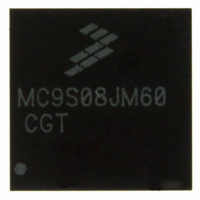MC9S08JM60CGT Freescale Semiconductor, MC9S08JM60CGT Datasheet - Page 276

MC9S08JM60CGT
Manufacturer Part Number
MC9S08JM60CGT
Description
IC MCU 8BIT 60K FLASH 48-QFN
Manufacturer
Freescale Semiconductor
Series
HCS08r
Datasheet
1.MC9S08JM32CLD.pdf
(388 pages)
Specifications of MC9S08JM60CGT
Core Processor
HCS08
Core Size
8-Bit
Speed
48MHz
Connectivity
I²C, LIN, SCI, SPI, USB
Peripherals
LVD, POR, PWM, WDT
Number Of I /o
37
Program Memory Size
60KB (60K x 8)
Program Memory Type
FLASH
Ram Size
4K x 8
Voltage - Supply (vcc/vdd)
2.7 V ~ 5.5 V
Data Converters
A/D 8x12b
Oscillator Type
External
Operating Temperature
-40°C ~ 85°C
Package / Case
48-QFN
Processor Series
S08JM
Core
HCS08
Data Bus Width
8 bit
Data Ram Size
4 KB
Interface Type
SCI/SPI
Maximum Clock Frequency
24 MHz
Number Of Programmable I/os
37
Number Of Timers
8
Maximum Operating Temperature
+ 85 C
Mounting Style
SMD/SMT
3rd Party Development Tools
EWS08
Development Tools By Supplier
DEMOJM, DEMOJMSKT, DEMOFLEXISJMSD, DEMO9S08JM16
Minimum Operating Temperature
- 40 C
On-chip Adc
8-ch x 12-bit
Cpu Family
HCS08
Device Core Size
8b
Frequency (max)
24MHz
Total Internal Ram Size
4KB
# I/os (max)
37
Number Of Timers - General Purpose
8
Operating Supply Voltage (typ)
3.3/5V
Operating Supply Voltage (max)
5.5V
Operating Supply Voltage (min)
2.7V
Instruction Set Architecture
CISC
Operating Temp Range
-40C to 85C
Operating Temperature Classification
Industrial
Mounting
Surface Mount
Pin Count
48
Package Type
QFN EP
Package
48QFN EP
Family Name
HCS08
Maximum Speed
24 MHz
Operating Supply Voltage
3.3|5 V
For Use With
DEMOJM - KIT DEMO FOR JM MCU FAMILYDEMOJMSKT - BOARD DEMO S08JM CARD W/SOCKET
Lead Free Status / RoHS Status
Lead free / RoHS Compliant
Eeprom Size
-
Lead Free Status / Rohs Status
Lead free / RoHS Compliant
Available stocks
Company
Part Number
Manufacturer
Quantity
Price
- Current page: 276 of 388
- Download datasheet (5Mb)
Timer/PWM Module (S08TPMV3)
The TPM channels are programmable independently as input capture, output compare, or edge-aligned
PWM channels. Alternately, the TPM can be configured to produce CPWM outputs on all channels. When
the TPM is configured for CPWMs, the counter operates as an up/down counter; input capture, output
compare, and EPWM functions are not practical.
If a channel is configured as input capture, an internal pullup device may be enabled for that channel. The
details of how a module interacts with pin controls depends upon the chip implementation because the I/O
pins and associated general purpose I/O controls are not part of the module. Refer to the discussion of the
I/O port logic in a full-chip specification.
Because center-aligned PWMs are usually used to drive 3-phase AC-induction motors and brushless DC
motors, they are typically used in sets of three or six channels.
16.2
Table 16-1
one to eight. When an external clock is included, it can be shared with the same pin as any TPM channel;
however, it could be connected to a separate input pin. Refer to the I/O pin descriptions in full-chip
specification for the specific chip implementation.
Refer to documentation for the full-chip for details about reset states, port connections, and whether there
is any pullup device on these pins.
TPM channel pins can be associated with general purpose I/O pins and have passive pullup devices which
can be enabled with a control bit when the TPM or general purpose I/O controls have configured the
associated pin as an input. When no TPM function is enabled to use a corresponding pin, the pin reverts
to being controlled by general purpose I/O controls, including the port-data and data-direction registers.
Immediately after reset, no TPM functions are enabled, so all associated pins revert to general purpose I/O
control.
16.2.1
This section describes each user-accessible pin signal in detail. Although
pins together, any TPM pin can be shared with the external clock source signal. Since I/O pin logic is not
part of the TPM, refer to full-chip documentation for a specific derivative for more details about the
interaction of TPM pin functions and general purpose I/O controls including port data, data direction, and
pullup controls.
276
Signal Description
shows the user-accessible signals for the TPM. The number of channels may be varied from
1
2
Detailed Signal Descriptions
When preset, this signal can share any channel pin; however depending upon full-chip
implementation, this signal could be connected to a separate external pin.
n=channel number (1 to 8)
TPMxCHn
EXTCLK
Name
1
2
External clock source which may be selected to drive the TPM counter.
I/O pin associated with TPM channel n
MC9S08JM60 Series Data Sheet, Rev. 3
Table 16-1. Signal Properties
Function
Table 16-1
Freescale Semiconductor
grouped all channel
Related parts for MC9S08JM60CGT
Image
Part Number
Description
Manufacturer
Datasheet
Request
R
Part Number:
Description:
Manufacturer:
Freescale Semiconductor, Inc
Datasheet:
Part Number:
Description:
Manufacturer:
Freescale Semiconductor, Inc
Datasheet:
Part Number:
Description:
Manufacturer:
Freescale Semiconductor, Inc
Datasheet:
Part Number:
Description:
Manufacturer:
Freescale Semiconductor, Inc
Datasheet:
Part Number:
Description:
Manufacturer:
Freescale Semiconductor, Inc
Datasheet:
Part Number:
Description:
Manufacturer:
Freescale Semiconductor, Inc
Datasheet:
Part Number:
Description:
Manufacturer:
Freescale Semiconductor, Inc
Datasheet:
Part Number:
Description:
Manufacturer:
Freescale Semiconductor, Inc
Datasheet:
Part Number:
Description:
Manufacturer:
Freescale Semiconductor, Inc
Datasheet:
Part Number:
Description:
Manufacturer:
Freescale Semiconductor, Inc
Datasheet:
Part Number:
Description:
Manufacturer:
Freescale Semiconductor, Inc
Datasheet:
Part Number:
Description:
Manufacturer:
Freescale Semiconductor, Inc
Datasheet:
Part Number:
Description:
Manufacturer:
Freescale Semiconductor, Inc
Datasheet:
Part Number:
Description:
Manufacturer:
Freescale Semiconductor, Inc
Datasheet:
Part Number:
Description:
Manufacturer:
Freescale Semiconductor, Inc
Datasheet:











